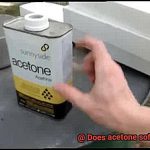Are you tired of staring at your outdated wallpapered walls and ready for a fresh new look? Perhaps you’re considering painting over the old wallpaper, but the thought of removing all the glue residues is daunting. Don’t worry, we’ve got you covered.
Let’s face it, removing wallpaper glue can be a tedious and time-consuming task that nobody wants to do. But before you start painting, it’s important to consider whether or not removing the glue is necessary.
In this blog post, we’ll explore the question of whether or not wallpaper glue needs to be removed before painting. We’ll discuss the pros and cons of removing it, factors that need to be considered, and practical tips to help make your decision easier.
Whether you’re a seasoned DIY enthusiast or new to home renovation, this post will provide you with all the information you need to make an informed decision about removing wallpaper glue before painting. So let’s dive in and finally answer the age-old question: Do you have to remove all wallpaper glue before painting?
What is Wallpaper Glue?
Contents
- 1 What is Wallpaper Glue?
- 2 Types of Wallpaper Glue
- 3 Do You Have to Remove All Wallpaper Glue Before Painting?
- 4 Factors to Consider When Deciding Whether or Not to Remove Wallpaper Glue
- 5 Removing Water-Soluble Glues
- 6 Removing Non-Water-Soluble Glues
- 7 Benefits of Leaving Some Adhesive Residue on Walls
- 8 Conclusion
Wallpaper glue, also known as wallpaper paste, is an essential component in the installation of wallpaper. This adhesive is used to attach wallpaper to walls and can come in both powder or pre-mixed form. Wallpaper glue is primarily made up of water, cellulose, and various chemicals.
There are several different types of wallpaper glue, each with its unique properties and intended use. The most common type of wallpaper glue is cellulose-based, which is easy to mix and apply, dries clear, and can be effortlessly removed if necessary. Wheat-starch-based glue is another popular option that provides a stronger bond and can be easier to remove. This glue is often used for delicate or expensive wallpapers. On the other hand, vinyl-based glue is specifically designed for use with vinyl wallpapers. It provides a strong and durable bond capable of withstanding moisture and humidity.
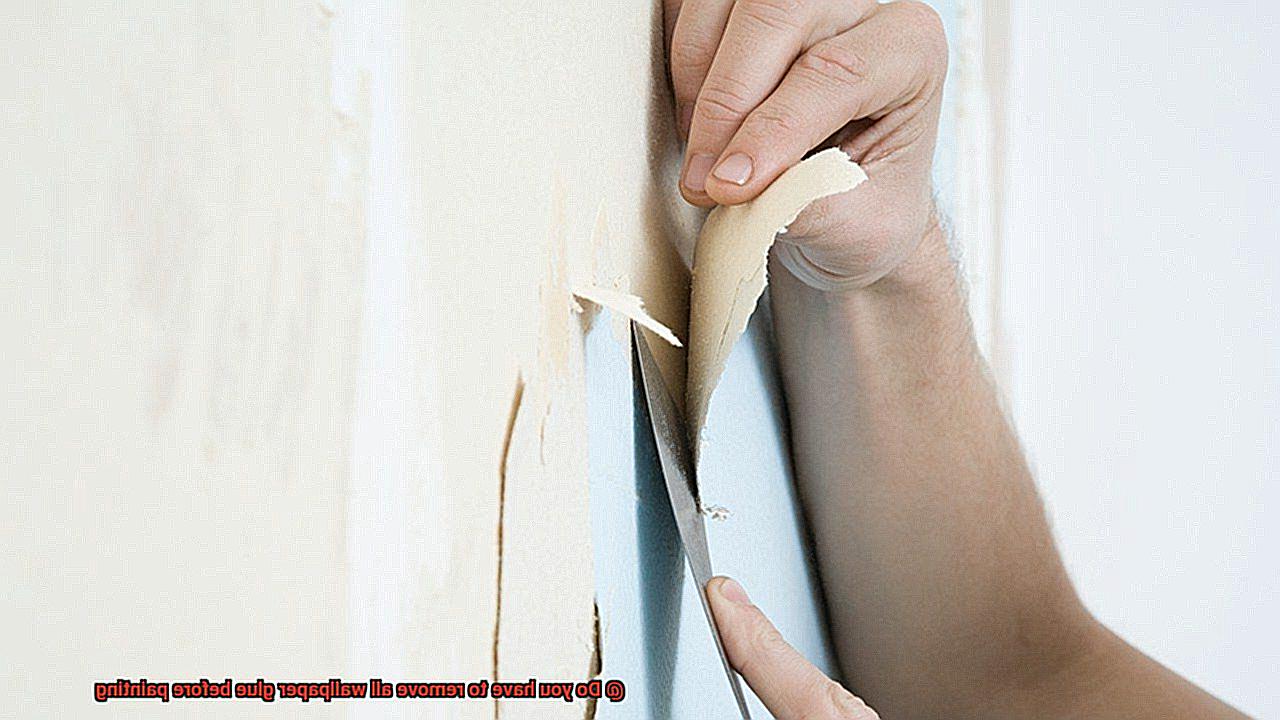
When deciding whether or not to remove all the wallpaper glue before painting, it’s important to consider the type of adhesive used. Some wallpaper glues are water-soluble and easy to remove by soaking the walls with warm water, while others require more effort to remove entirely. In such cases, using a chemical wallpaper stripper can help dissolve the adhesive, making it easier to scrape off with a putty knife or scraper.
It’s also important to consider the condition of the walls before deciding whether or not to remove all the wallpaper glue. Leaving some adhesive residue behind can help fill in minor wall imperfections, creating a smoother surface for painting. Ultimately, the decision to remove all wallpaper glue before painting should be based on the specific circumstances of each project.
Wallpaper glue plays a vital role in the installation of wallpaper and can significantly impact the overall appearance and durability of the finished product. Proper selection and application of the appropriate type of adhesive are crucial to ensuring a successful installation. Here are some additional tips to keep in mind:
- Always read the instructions carefully before mixing or applying wallpaper glue.
- Make sure the walls are clean, dry, and free of any bumps or imperfections before applying wallpaper glue.
- Use a paintbrush or roller to apply wallpaper glue evenly to the back of the wallpaper.
- Allow the wallpaper to rest for a few minutes before hanging it on the wall.
- Smooth out any bubbles or wrinkles in the wallpaper using a wallpaper brush or smoothing tool.

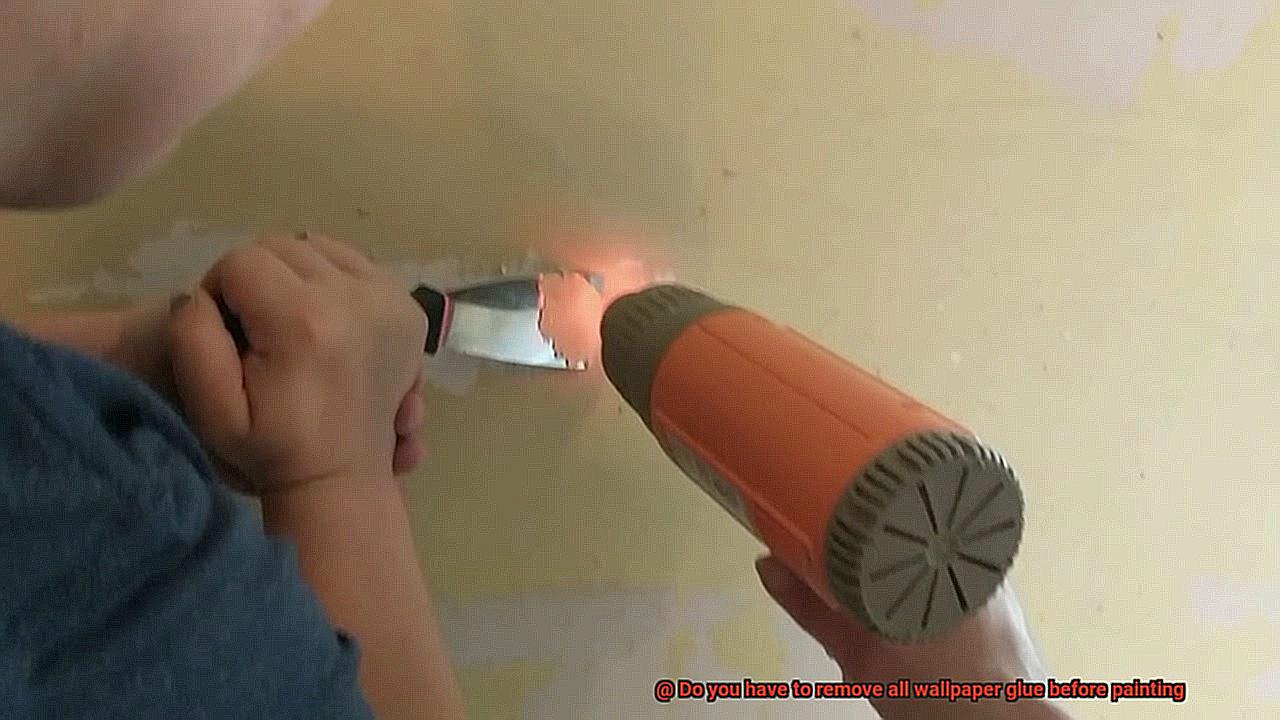
Types of Wallpaper Glue
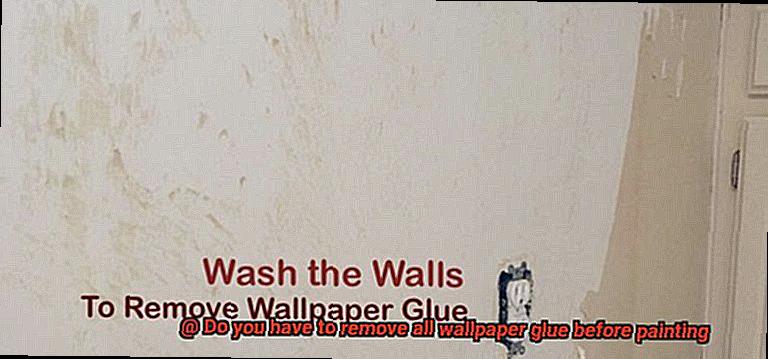
When it comes to removing old wallpaper, choosing the right glue can make a significant difference in the outcome of your project. With so many types of wallpaper glue available, it’s essential to understand their unique features and benefits. Here are six types of wallpaper glue you should know about:
Cellulose-Based Wallpaper Glue
If you’re working with paper-based wallpapers, then cellulose-based wallpaper glue is a great option. Made from plant-based materials and mixed with water to create a paste, this type of glue is easy to mix and apply, making it a popular choice among DIY enthusiasts.
Vinyl-Based Wallpaper Glue
Vinyl-based wallpaper glue is designed to work with vinyl wallpapers. It has a strong adhesive quality that is perfect for sticking vinyl wallpapers to surfaces. Additionally, this type of glue is resistant to moisture and humidity, making it an excellent choice for bathrooms and kitchens.
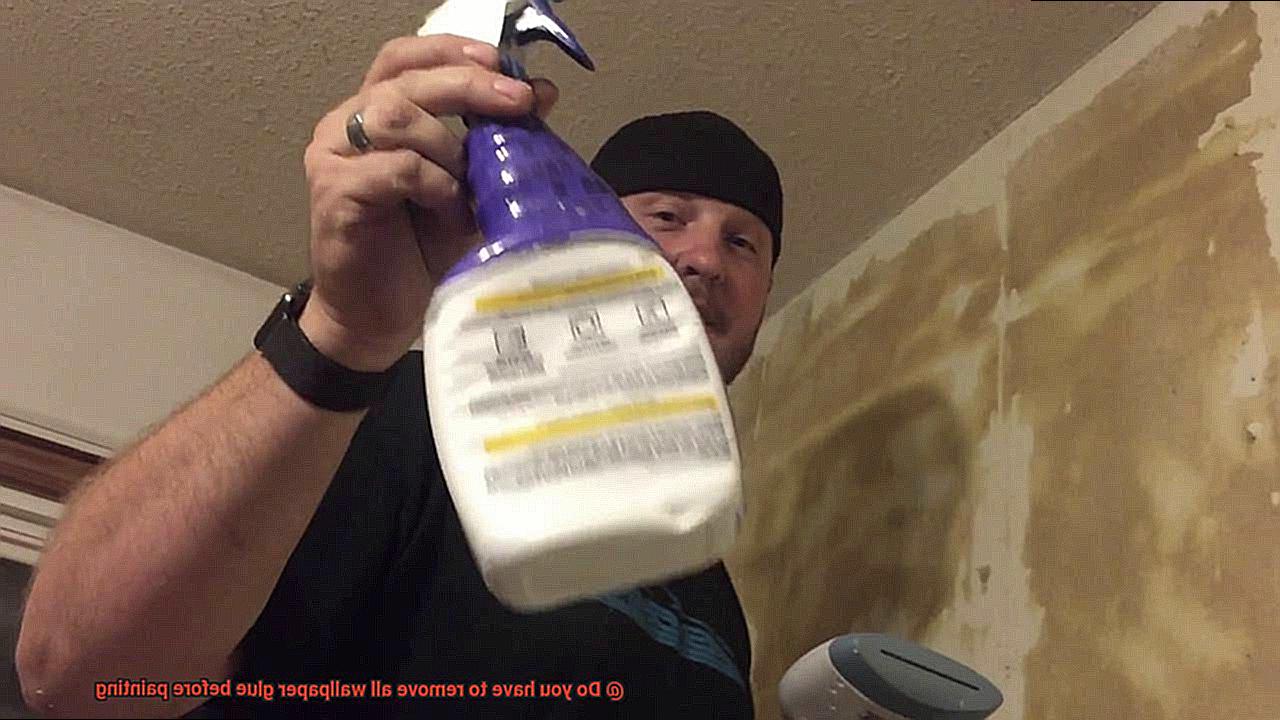
Clay-Based Wallpaper Glue
For people who are allergic to chemicals or prefer eco-friendly options, clay-based wallpaper glue is an ideal choice. Made from natural clay and mixed with water to create a paste, this type of glue is suitable for all types of wallpapers and can be easily removed with water.
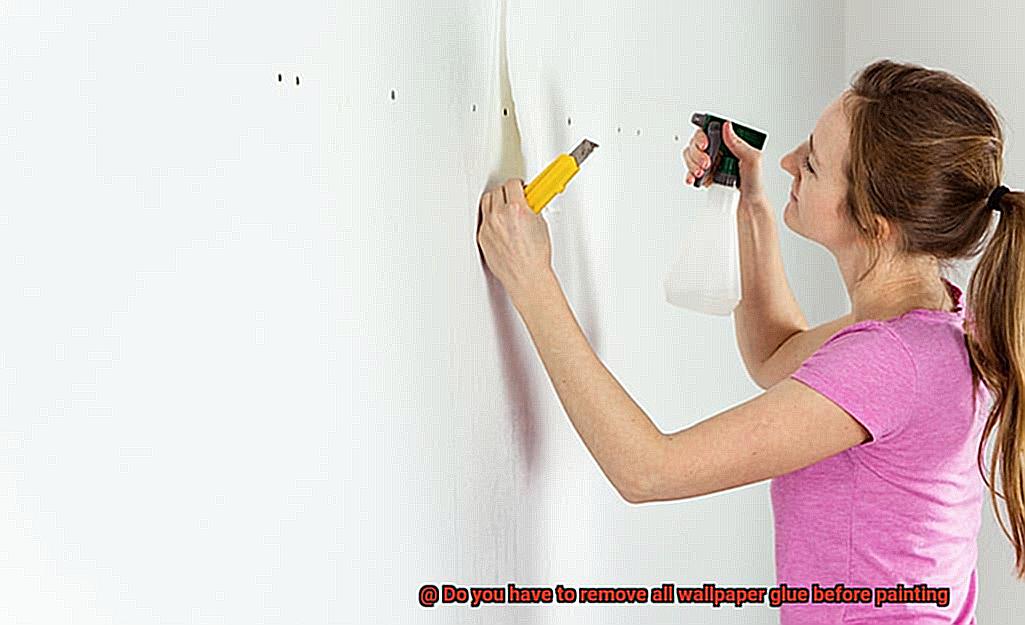
Wheat-Based Wallpaper Glue
For a non-toxic alternative, wheat-based wallpaper glue is an excellent option. Made from wheat starch and mixed with water to create a paste, this type of glue is suitable for most types of wallpapers except vinyl.
Ready-Mixed Wallpaper Adhesives
If you don’t want to bother with mixing your own paste, ready-mixed wallpaper adhesives are available. These adhesives come in a tub or bucket and are ready to use right out of the container, saving you time and effort.
Specialty Wallpaper Adhesives
Finally, there are specialty wallpaper adhesives available for specific types of wallpaper. Heavy-duty adhesives may be needed for thicker or heavier wallpapers, while non-staining adhesives may be necessary for delicate or light-colored wallpapers.
Do You Have to Remove All Wallpaper Glue Before Painting?
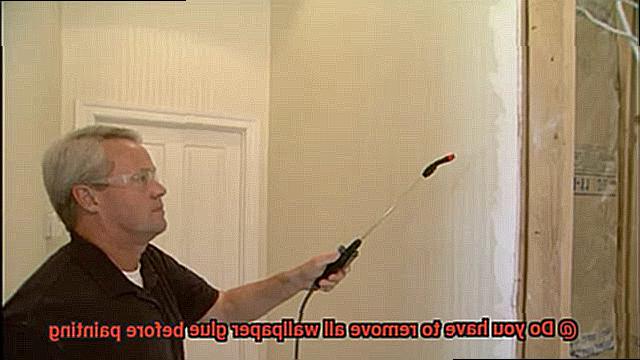
Imagine walking into a room with freshly painted walls, only to see bubbles, cracks, and peeling paint. Yikes. That’s exactly what can happen if you don’t remove all the wallpaper glue before painting. So, to answer the question “Do You Have to Remove All Wallpaper Glue Before Painting?” – the answer is a resounding yes.
Why is removing all wallpaper glue so important? Well, it’s because wallpaper glue can prevent paint from properly adhering to the wall. Any leftover residue creates a barrier that prevents the paint from bonding with the surface. This can lead to uneven coverage, blotchy spots, and an overall poor finish.
But don’t worry, there are a few methods you can use to remove wallpaper glue. One popular option is using a wallpaper stripper solution that softens the glue and makes it easy to scrape off with a putty knife or scraper. Another option is using hot water and a sponge or cloth to moisten the glue and then gently scrape it away. Regardless of which method you choose, patience is key. Taking your time ensures all traces of glue are removed before you start painting.
Once you’ve removed all the wallpaper glue, you’re ready to start painting. But wait, there are a few things to keep in mind before diving in. Here’s a quick checklist for you:
- Ensure all wallpaper glue has been removed
- Clean the walls thoroughly
- Apply a high-quality primer
- Choose paint specifically designed for walls (avoid paint and primer in one)
- Apply two coats of paint for best results
By following these steps, you’ll create a smooth and professional-looking finish that will last for years to come.
Factors to Consider When Deciding Whether or Not to Remove Wallpaper Glue
Firstly, the type of paint you plan on using is key. If you’re opting for an oil-based paint, then removing all of the wallpaper glue beforehand is highly recommended. Oil-based paints struggle to adhere well to surfaces with any residue or debris left on them, and removing the glue will help ensure that your paint adheres properly.
Another essential factor is the condition of your walls. If they’re in pristine condition without any damage or dents, leaving some of the glue on the walls may be acceptable. However, if there are any imperfections or damaged areas, it’s best to remove all of the glue before painting.
The age of your wallpaper also plays a significant role. If it’s been on the walls for a lengthy period and is beginning to peel or come off in certain areas, it’s best to remove all of the glue before painting. This step will ensure that your new paint adheres appropriately and doesn’t peel off later on.
Furthermore, it’s crucial to take your personal preference and desired outcome into account. If you’re seeking a completely smooth and seamless finish, removing all of the wallpaper glue before painting is the way to go. However, if you don’t mind a slightly textured finish or are on a tight budget, leaving some of the glue on the walls may be an option.
Removing Water-Soluble Glues
Removing water-soluble glue may seem like a daunting task, but fear not. As an expert in removing water-soluble glues, I have all the tips and tricks you need to make sure your painted walls look their best.
First things first, make sure all traces of wallpaper and its backing are removed from the wall surface. This will make it easier for you to target the glue specifically. Once that’s done, it’s time to get started.
You’ll need these basic tools:
- A bucket
- Warm water
- A sponge or cloth
- A scraper or putty knife
Begin by mixing warm water in a bucket and saturating the wall surface with the solution. Allow the water to sit for a few minutes to soften the glue. The magic of water-soluble glue is that it dissolves when exposed to water, making it easier to remove compared to other types of adhesives.
Next, use a scraper or putty knife to gently scrape away the softened glue. Take care not to gouge or damage the wall surface in the process. If there are particularly stubborn areas of glue, repeat the process several times until all traces of glue have been removed.
It’s important to note that some water-soluble glues contain additives or chemicals that may require special cleaning solutions or techniques. If you’re unsure, seek professional help or advice.
Once all traces of glue have been removed, it’s time to thoroughly clean and dry the wall surface before painting. This step is crucial in ensuring that the paint adheres properly and that there are no residual traces of glue that could affect the final finish.
Removing Non-Water-Soluble Glues
First things first, identifying the type of adhesive used is crucial. Cellulose paste is a common type of non-water-soluble glue used for wallpaper installation. This natural material can be difficult to remove once it has dried. However, with some warm water and a scraper or putty knife, you can make it disappear. Soak the wallpaper with warm water and wait a few minutes for it to soften. Then, gently use the scraper or putty knife to remove the wallpaper and any remaining adhesive residue.
On the other hand, vinyl adhesive is an even more challenging adversary. It is typically used for vinyl wallpapers and requires a special solvent designed specifically for this purpose. Apply the solvent to the wallpaper and wait for a few minutes before using a scraper or putty knife to remove the wallpaper and adhesive residue.
It’s important to note that removing non-water-soluble glue is a time-consuming and labor-intensive task that requires patience and perseverance. If you’re not comfortable doing it yourself, consider hiring a professional who has experience in wallpaper removal.
Before painting over the wallpaper, ensure that all the adhesive residue is removed from the surface. Otherwise, the paint may not adhere properly to the wall. It’s always better to be safe than sorry.
Benefits of Leaving Some Adhesive Residue on Walls
Before you break out the scraper and start working up a sweat, consider this – leaving some adhesive residue on your walls can offer surprising benefits when it comes to painting.
When the residue left behind is minimal and evenly distributed, it can act as a primer for new paint, providing an easier surface to adhere to. Furthermore, the remaining glue can fill in small cracks or imperfections on your walls, creating a smoother and more consistent paint job. This helps to achieve a professional and polished look with less effort.
But wait, there’s more. By opting to leave some adhesive residue on your walls, you can save yourself valuable time during the painting process. Removing all of the residue can be a tedious and time-consuming task, and if it is not essential for high-quality results, leaving some behind can be more efficient.
Of course, it’s important to note that these benefits only apply if the adhesive residue is minimal and evenly distributed. If there are large clumps or uneven patches of residue, it’s best to remove them before painting to ensure a smooth finish. Always test a small area first before committing to leaving any residue on the wall since different types of adhesive may have varying effects on the paint job.
IpyTzHydVBQ” >
Conclusion
To wrap up, the decision of whether or not to remove all wallpaper glue before painting is a common dilemma for homeowners seeking to revamp their walls. While it may seem like an arduous and time-consuming task, it is imperative for achieving a polished and seamless end result. When deciding whether or not to remove all glue residues, factors such as the type of adhesive used, wall condition, and personal preference must be taken into account.
There are various types of wallpaper glue available in the market today, including cellulose-based, vinyl-based, clay-based, wheat-based, ready-mixed adhesives, and specialty adhesives. Each has its unique features and benefits that should be carefully considered when selecting an appropriate adhesive.
Removing water-soluble glues involves saturating the wall surface with warm water and gently scraping away the softened glue with a scraper or putty knife. Non-water-soluble glues require special solvents designed specifically for this purpose.
Interestingly enough, leaving some adhesive residue on walls can offer surprising advantages when it comes to painting. Minimal and evenly distributed residue can act as a primer for new paint while filling in small cracks or imperfections on walls. However, if there are large clumps or uneven patches of residue present on walls, it’s best to remove them before painting to ensure a smooth finish.
In summary, taking the time to remove all wallpaper glue residues before painting is crucial for achieving a professional-looking finish that will last for years to come.






